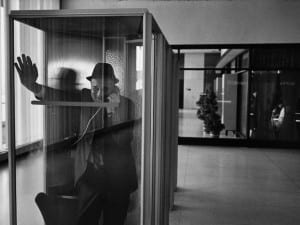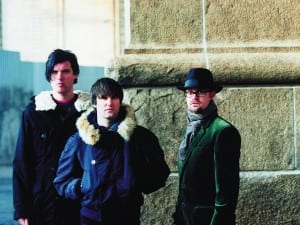The Coen Brothers’ Inside Llewyn Davis is an intimate tale of the Greenwich Village folk scene of 1961. We speak to cinematographer Bruno Delbonnel about his visual interpretation.
It’s a truism that “history is written by the victors”, but behind the headlines and successes are many, many more who didn’t make it, the dreamers and failures whose story is unheard and unwanted for lacking glamour and a tidy ending. The latest film from Joel and Ethan Coen combines the musical focus of O Brother Where Art Thou (2000) with the existential preoccupations of a rarely investigated period in American music history. Inside Llewyn Davis follows the titular character as he trudges through the unforgiving New York winter of 1961, experiencing one misfortune after another as he pursues his dream of being a solo folk artist after the suicide of his singing partner.
We are introduced to Llewyn in a dingy, Greenwich Village folk bar, singing Hang Me to a disinterested crowd. It’s the last song of his set and he steps down from the stage to a smattering of applause and a message from the proprietor that he has a visitor outside. In the dark, rain-soaked alleyway, Llewyn is casually beaten up for heckling yesterday’s act and is left a doleful figure who must pick himself up and coerce one of his understanding friends into lending him a bed for the night. Llewyn’s beating is sudden and brutal, the blows and grunts align you intimately with his suffering and you can feel his winded stomach and wounded pride. We learn that Llewyn is homeless, imposing on different friends each night to sleep on sofas and enjoy some shelter while he waits impatiently for earnings from his first solo album to come his way. But on visiting his manager, it’s clear there’s nothing there. Llewyn’s career has bombed, and, along with countless other folk musicians across the Village, he has the boxes of unsold vinyl to prove it. Consigned to walking the streets, reliant on the hospitality of acquaintances and with no winter coat against the harsh New York elements, Llewyn is a sorry figure before the story even begins, and then his misfortunes escalate and spiral.
The initial idea came to the Coens on stumbling across a copy of The Mayor of MacDougal Street, the unfinished memoir of Dave Van Ronk, which was completed as a series of interviews by the journalist Elijah Wald after Van Ronk’s death in 2002. They immersed themselves in the period and its music and developed the screenplay organically from one initial scene of a folk singer being beaten up in an alleyway. Although the film is not biographical, elements of Van Ronk’s story (such as his trip to Chicago to audition for Al Grossman, Bud Grossman in the film) are woven through the script. Furthermore, while Llewyn performs traditional folk songs often associated with Van Ronk, the performances avoid paying homage to Van Ronk’s style. Oscar Isaac in the title role embraces the difference in his and Von Rank’s style and, with a fuller tenor to his voice in contrast to Van Ronk’s more nasal, traditionally folk tone, the character avoids becoming a pastiche, and holds the audience’s attentions on his own merits.
It’s these performances that mesmerise at times, but with its cold pervasive melancholy, Inside Llewyn Davis is not an extended music video, nor is it a look into the glamorous, bohemian lifestyle and heady success of many a biopic. It’s a damning indictment of dreams and the naivety of dreamers. Interrogating the New York folk scene of 1961, when the genre was developing but still fairly underground, just before a young Bob Dylan was about to take the genre and successfully run with it for decades to come, the Coens have developed an overlooked area of American music history, and whittled it down to one man’s personal struggle, with a bittersweet charm.
For a while, Llewyn stays with the Gorfeins, kind Upper West Side academics, who look sympathetically on his struggle, but he leaves their apartment only to have their cat escape with him. With nowhere for him or the cat to go, he hikes downtown to leave it at his best friend Jim’s house, where he is later confronted by Jim’s angry wife, Jean, announcing she is pregnant and that Llewyn needs to find money for an abortion. After visiting his manager and his sister, Llewyn’s funds are still dry, but he finally scores a break recording Jim’s satirical anti-war anthem, Please Mr Kennedy (but not before insulting its songwriter). However, even this small concession turns back to haunt Llewyn and his bad decision-making – eschewing all royalties for a faster-payment flat fee the song grows to be a massive hit, but Llewyn is still penniless. He learns that years before another lover missed her planned abortion of his child, that he has returned the wrong cat to the Gorfeins, and that his sister has discarded his merchant marine papers, and with it his hopes of a regular income once his ambition runs out. Llewyn ends as he began, in a perfectly crafted and cyclical screenplay.
Also along the way, an ill-fated trip to Chicago with the drug-addled jazzman Roland Turner and his driver Jonny Five, sees Llewyn’s audition with a renowned music producer fall flat with a simple: “I don’t see any money in this.” Herein lies the struggle that rests at the heart of the protagonist’s existence – and shared by artists throughout history – the compulsion to keep creating, keep challenging, and to keep going, clashing against a desperate need to not “sell out.” While Llewyn sees himself as a serious artist, his art is not paying the bills, and yet there’s a consensus in many creative communities that once something becomes popular (and profitable) it negates its artistic worth. It’s this earnest scene, this consistent desire for authenticity, that attracted Joel and Ethan Coen to this specific period in New York, and everything else grew up around the discovery of that scene.
Taking the title role, Oscar Isaac is cynical and morose but realises a certain empathy for his downbeat, listless character. Llewyn Davis hopelessly flits from sofa to sofa, he sponges off his friends, sleeps with his best friend’s wife and abandons a defenceless cat and an overdosed jazz musician on the side of the freeway, but somehow he holds the audience’s attention through every scene of the film – not a hero, as such, but perhaps an everyman down on his luck. Isaac captures this perfectly, and his performances hold the screen and immerse the audience in the music. Meanwhile, Justin Timberlake is hilarious as the loveable, upbeat, cuckolded Jim, and his rendition of Please Mr Kennedy, in addition to Llewyn’s unintentional rebuff, provides one of the lighter moments of comedy in the film. The most notable performance, however, comes from Carey Mulligan as Jean, whose vitriolic attack on Llewyn for getting her pregnant plays completely against type and lights up the screen. Bitter and venomous, in contrast to her saccharine husband, Jean’s earlier kindnesses to Llewyn are negated and become a hot-headed, expletive-filled screaming match, darkly humorous for the infidelity, betrayal and abortion it discusses. Nonetheless, it is quick-witted and hilarious – “You’re like King Midas’ idiot brother, everything you touch turns to shit!”
Inside Llewyn Davis is an intensely intimate film, but it also captures a timeless impression of New York as the cold, wet, inhospitable setting of broken dreams. Academy award nominated cinematographer Bruno Delbonnel (A Very Long Engagement, Harry Potter and the Half-Blood Prince ) seized on the mood of the screenplay and the lead role from the start and built the film’s aesthetic from this: “What I was looking for was a kind of melancholy and sadness and when I found it everything became easy.” The filming follows Llewyn from smoky bolthole to rain-soaked alleyway, from crisp New York streets to dingy apartments, and from down-at-heel offices, diners and service stations to a majestic soundstage and all that it promises … only to follow him right back down to earth again. Throughout this narrative arch the visual mood of the film remains the same, and Delbonnel emphasises: “For me a movie is about consistency. You have to be unwavering throughout the whole film with the look you provide. However, because of this, it was not so difficult because everything was connected to the story. When you find the right idea and you stick to it, you don’t have a second thought and you go for it.”
Of the overarching cinematography and his collaboration with the Coens, Delbonnel says: “The main idea was a fleshy winter in New York with its coldness, so that was the starting point. I added a sadness and melancholy to it, which they agreed, basically because there’s no fun … cities can be very sad when it’s quiet.” Thus, everything is captured and portrayed in this subdued morose style. The bright lights of the city or of autumn sunshine that we so often associate with New York are rejected for the type of light “that doesn’t reach the end of the set, or the other side of the apartment where you live, and where you have to turn the light on at noon … I used a lot of soft light, which for me is the opposite of sunshine. A beam of light enriching something wouldn’t have fitted the story, I guess.”
Delbonnel continues: “It’s not really about the folk music scene, even though the folk music is the background. It’s more about this character and how he can succeed or not succeed in a special art form. And it’s the anticipation of the big storm that was coming with Bob Dylan. It’s [questioning] why would Bob Dylan flourish when this guy, Llweyn, who is very talented but probably doesn’t connect with people, does not.” However, the story is as much focused on the music as the screenplay, and there’s a sense that this specific moment in folk (from the late 1950s to Dylan’s success in late 1961) attracted the Coens and initiated telling the tale of Llewyn. In the opening scene, the smoke, dim lighting and clustered figures are atmospheric, our proximity to Llewyn is intimate, and the appreciation of the music stripped back to the simplest acoustics is innate. To open on an intimate scene, in terms of the cinematography: “You basically work backwards. Usually when you start a film you establish a master shot, a wider shot where you state the direction of everything. For this kind of performance you begin with a close-up [but] I needed to match the close-up with the wide shot that I’m doing later, so I needed to capture the general tone of the whole picture.”
Unusually the songs in the film are performed live and in their entirety, giving a richness and authenticity to the performances and the scene they represent, but also enabling the viewer to share in the hopes, fears and anxieties of the performers. Delbonnel describes the first scene, in which Llewyn sings Hang Me as his acknowledgement that “I’m an asshole, I know that” while his closing performance of Dink’s Song is Llewyn’s goodbye. Because “every song was very connected to the script, it wasn’t like a performance of somebody on stage as in a music video. Everything was linked to the story and we picked the right songs with that in mind.” In this way the music is at the centre of the film; it is after all, what binds the characters together and creates a cohesive narrative. Collaborating with the legendary music producer T Bone Burnett (O Brother, Where Art Thou? and Walk the Line ) the Coens have created more than a soundtrack. It’s the backbone of the film, formed from contemporary songs of the period, such as 500 Miles and Dink’s Song, with a smattering of original compositions (the soundtrack also includes performances from Mumford and Sons, Punch Brothers and Lost City Ramblers) and infuses the film with the earnest melancholy of its time.
As Llewyn despairingly comments on his opening performance, “if it was never new, and it never gets old, then it’s a folk song,” and this timelessness pervades the film and its protagonist’s Ground Hog Day fate. The film opens on a low, and it ends in exactly the same manner – with Llewyn beaten up and returning to the Gorfeins. Depressingly resigned to his fate as an also-ran, there’s a sense that Llewyn will continue dreaming and dwelling, failing in perpetuity, in a cycle that mimics the composition of many a folk song.
Inside Llewyn Davis is showing in UK cinemas now. For further information, visit www.insidellewyndavis.com.
Ruby Beesley





